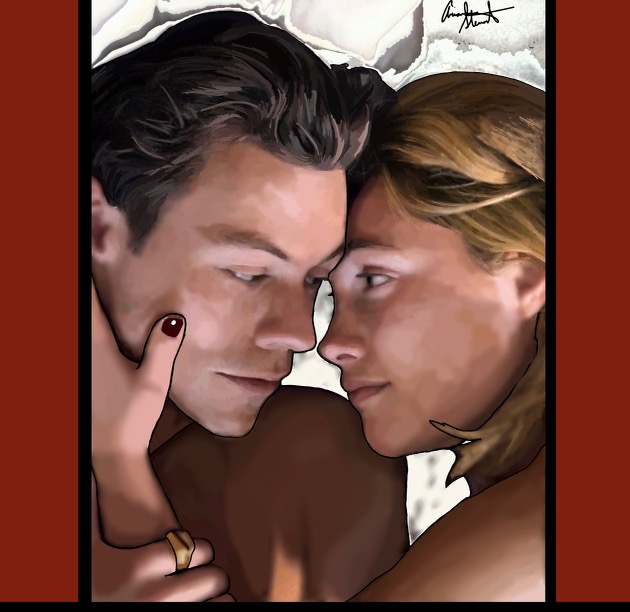Harry Styles is in “Don’t Worry Darling,” and that’s about it. When everyone heard that Styles *gasp* would be in a movie *GASP* directed by Olivia Wilde *GASP* with Florence Pugh *GASP*, there was palpable excitement. However, following the actual release of the movie, the hype started to falter and wane.
”Don’t Worry Darling” follows the story of the housewife Alice — played by Pugh — and her husband Jack — played by Styles — as she slowly realizes that the picturesque life she enjoys is a simulation that Jack has unwillingly placed her into. The town where the pair live, Victory, is actually an elaborate fabrication created by the Victory Project, a radical fringe group focused on giving men the lives and wives they “deserve.”
Styles, the supposed centerpiece of the movie, doesn’t deliver on the promise of being the leading man that “Don’t Worry Darling” desperately needs. His performance, although not lacking in intensity or appeal, feels shallow and without nuance. The scene poised to be his character’s emotional apex feels like the work of someone who watched a “Top 10 Best Acting Performances” TikTok and decided to try their hand.
Styles being cast as the lead in a movie about the problematic aspects of male control presents a quandary within itself. His “one-of-the-good-ones” and “white-boy-of-the-month” status adds a layer that the film fails to contend adequately with. Styles is too nice for this role. Even though his character Jack steals his girlfriend Alice’s agency and life from her, he’s still a doting husband and a loyal partner within the nondescript retro simulation of Victory. If this choice is some kind of intentional meta-commentary on the seductive power of celebrity even in the face of obvious evil, it gets lost in translation.
Style’s performance feels especially flat next to Pugh, whose performance is imbued with barely contained desperation. Although her character, Alice, isn’t fully developed in any sense (we know nothing about her beliefs or ambitions, just that she was a surgeon and enjoyed it), Pugh is able to imbue her with some semblance of humanity, seemingly through sheer force of will. It’s as if the emotions we see claw their way out, pushing to and past the edges of the screen, whereas Styles feels more like a conveyor belt of attractiveness and good-guy placation.
“Don’t Worry Darling” definitely delivers on its promise of a visually decadent and cohesive experience. Set Decorator Rachael Ferrara, Costume Designer Arianna Phillips and Art Directors Mary Florence Brown and Erika Toth deserve praise for giving us the one unimpeachable thing about the film: its aesthetic. Everything fits in a way that perfectly balances perfectionist satisfaction and feeling of carbon-copy uneasiness. The costumes and styling convey a sense of timelessness; there’s 1940s waves, 1960s beehives, and 1970s blowouts. Watching the immaculately coiffed women float around in kitten heels, harmonious but just a beat incongruous, you get the sense that they’re all emulating something monolithic yet nonexistent. Additional details like live clothing models in glass cases, crisp white walls and the omnipresence of a blinding California sun bring it all together.
One would think that in a movie where visuals are such an obvious focus of the production process, the visuals would be trusted to do a majority of the world-building. This is not the case of “Don’t Worry Darling.” The first hour is almost entirely exposition — it dwells on the minutiae of the Victory Project, gives us sweeping sunny views of the peaceful daily life of its cast of characters. “Don’t Worry Darling” either doesn’t trust the visual elements to hold their own or would prefer to luxuriate in the banality of the archaic realm of domesticity that it claims to abhor, and it wastes our time in the process.
When visual storytelling is utilized, it’s beaten into us with a metal bat. The eye symbolism used to convey the ubiquity of the Victory Project’s control emerges too late, too abruptly and is ground into us too incessantly to feel nuanced or even artistic. The plane seen throughout the movie and featured heavily in the promotional materials makes some sparse and vacant appearances, but nothing enough to sink your teeth into.
“Don’t Worry Darling” was originally framed as a feminist magnum opus, a spiritual successor to “Booksmart” and a shinier, more modern “Stepford Wives” for a new wave of feminists. But unfortunately, something about it just doesn’t deliver. Wilde originally impressed the importance of female pleasure and the “female gaze” in the film, but this pleasure happens in a situation where the female character is essentially devoid of true agency. The film centers on the evilness of the men putting these women in the Victory Project but neglects to contend with the possibility of evil once they’re there.
The film exists in its own kind of fantasy and relishes in a world in which the men who would rob women of their agency and force them into a simulation would treat them humanely once they have the upper hand. The couples we see in Victory are all at least amicable, if not perfect; there’s never an allusion to coercion within the simulation, just the coercion to get them into it. The kind of “safe violence,” that would lead a man to put a woman in a simulation, but not to mistreat her inside said simulation, reveals a weakness within the film. Violence against women is up for consideration, sure, as long as it’s clean, novel and reversible once you blink.
Most of the issues with “Don’t Worry Darling” fall along the same fault lines — if there was ever an intellectual, groundbreaking movie to be made here, this isn’t it.

